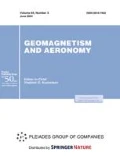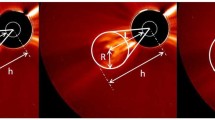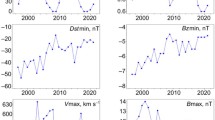Abstract
The correlation of the variations in geomagnetic cutoff rigidity of cosmic rays ΔR with the interplanetary medium parameters and geomagnetic activity indices Dst and Kp was calculated for different phases of the superstorm on November 7–8, 2004. The strongest correlation was observed between the cutoff rigidity and Dst at all stages of storm development (correlation coefficients k ≈ 0.70–0.98); some stable influence of the solar wind (SW) density N (k ≈ 0.50–0.80) should also be noted. The dependence of the cutoff-rigidity variation on all of the dynamic parameters of the SW is observed in the main storm phase and is especially strong for the density N and pressure P. The correlation between ΔR and V is negative in all phases, while the correlation of ΔR with N and P is positive during the main phase and negative in the recovery phase. The cutoff-rigidity variations showed no sensitivity to the Bz component of the interplanetary magnetic field (IMF), the azimuthal component By, or the IMF absolute value B before the storm or in its main phase. A significant correlation or anticorrelation of ΔR with B and all the IMF components is observed only in the recovery period. The specific response of the geomagnetic cutoff rigidity to the heliospheric and magnetospheric parameters at different phases of the magnetic storm is apparently determined by the different relative contributions of the magnetospheric global current systems during these periods.


Similar content being viewed by others
REFERENCES
Adriani, O., Barbarino, G.C., Bazilevskaya, G.N., et al., PAMELA’s measurements of geomagnetic cutoff variations during the 14 December 2006 storm, Space Weather, 2016, vol. 14, no. 3. https://doi.org/10.1002/2016SW001364
Akasofu, S.I., Energy coupling between the solar wind and the magnetosphere, Space Sci. Rev., 1981, vol. 28, pp. 121–190. https://doi.org/10.1007/BF00218810
Bieber, J.W., Chen, J., Mathaeus, W.H., Smith, C.W., and Pomerantz, M.A., Long-term variations of interplanetary magnetic field spectra with implications for cosmic ray modulation, J. Geophys. Res., 1993, vol. 98, pp. 3585–3603. https://doi.org/10.1029/92JA02566
Burov, V.A., Meleshkov, Yu.S., and Ochelkov, Yu.P., A technique of operational assessment of the radiation hazard level due to space weather disturbances during air transportation, Geliogeofiz. Issled., 2005, no. 7, pp. 1–41.
Crooker, N.U., Solar and heliospheric geoeffective disturbances, J. Atmos. Sol.-Terr. Phys., 2000, vol. 62, pp. 1071–1085.
Danilova, O.A., Demina, I.A., Ptitsyna, N.G., and Tyasto, M.I., Mapping of geomagnetic cutoff rigidity of cosmic rays during the main phase of the magnetic storm of November 20, 2003, Geomagn. Aeron. (Engl. Transl.), 2019, vol. 59, no. 2, pp. 147–154.
Dungey, J.W., Interplanetary magnetic field and the auroral zones, Phys. Rev. Lett., 1961, vol. 6, pp. 47–48. https://doi.org/10.1103/PhysRevLett.6.47
Dvornikov, V.M., Kravtsova, M.V., and Sdobnov, V.E., Diagnostics of the electromagnetic characteristics of the interplanetary medium based on cosmic ray effects, Geomagn. Aeron. (Engl. Transl.), 2013, vol. 33, no. 4, pp. 430–440.
Ermolaev, Yu.I., Zelenyi, L.M., Zastenker, G.N., et al., Solar and heliospheric disturbances that resulted in the strongest magnetic storm of November 20, 2003, Geomagn. Aeron. (Engl. Transl.), 2005, vol. 45, no. 1, pp. 20–46.
Fenrich, F.R. and Luhman, J.D., Geomagnetic responses to magnetic clouds of different polarity, Geophys. Res. Lett., 1998, vol. 25, pp. 2999–3002.
Flueckiger, E.O., Smart, D.F., and Shea, M.A., Determining the strength of the ring and the magnetopause currents during the initial phase of a geomagnetic storm using cosmic ray data, J. Geophys. Res., 1990, vol. 95, no. A2, pp. 1113–1118.
Iucci, N., Levitin, A.E., Belov, A.V., et al., Space weather conditions and spacecraft anomalies in different orbits, Space Weather, 2005, vol. 3, S01001. https://doi.org/10.1029/2003SW000056
Kalegaev, V.V., Vlasova, N.A., and Peng, Z., Dynamics of the magnetosphere during geomagnetic storms on January 21–22, 2005 and December 14–15, 2006, Cosmic Res., 2015, vol. 53, no. 2, pp. 98–110.
Kane, R.P., How good is the relationships of solar and interplanetary plasma parameters with geomagnetic storms?, J. Geophys. Res., 2005, vol. 110, no. A2. https://doi.org/10.1029/2004JA010799
Kanekal, S., Baker, D., Blake, J., Klecker, B., Cummings, J., Mewaldt, R., Mason, G., and Mazur, J., High-latitude energetic particle boundaries and the polar cap: A statistical study, J. Geophys. Res.: Space, 1998, vol. 103, pp. 9367–9372.
Khabarova, O.V., Current problems of magnetic storm prediction and possible ways of their solving, Sun Geosphere, 2007, vol. 2, no. 1, pp. 32–37.
Khabarova, O.V. and Rudenchik, E.A., Peculiarities of solar wind and IMF oscillatory regime’s changes before geomagnetic storms. Wavelet analysis results, Vestn. Otd. Nauk Zemle Ross. Akad. Nauk, 2003, no. 1, pp. 1–28.
Kress, B.T., Mertens, C.J., and Wiltberger, M., Solar energetic particle cutoff variations during the 29–31 October 2003 geomagnetic storm, Space Weather, 2010, vol. 8, S05001.
Kress, B.T., Hudson, M.K., Selesnick, R.S., Mertens, C.J., and Engel, M., Modeling geomagnetic cutoffs for space weather applications, J. Geophys. Res.: Space Phys., 2015, vol. 120, no. 7, pp. 5694–5702. https://doi.org/10.1002/2014JA020899
Leske, R.A., Mewaldt, R.A., Stone, E.C., and von Rosenvinge, T.T., Observations of geomagnetic cutoff variations during solar energetic particle events and implications for the radiation environment at the space station, J. Geophys. Res., 2001, vol. 106, pp. 30011–30022. https://doi.org/10.1029/2000JA000212
Levitin, A.E., Dremukhina, L.A., Gromova, L.I., and Ptitsyna, N.G., Magnetic disturbance generation during the historic magnetic storm in September 1859, Geomagn. Aeron. (Engl. Transl.), 2014, vol. 54, no. 3, pp. 300–307.
McCracken, K.G., Rao, U.R., and Shea, M.A., The trajectories of cosmic rays in a high degree simulation of the geomagnetic field, Mass. Inst. Technol. Tech. Rep. 77, Cambridge, 1962.
Mishra, R.K. and Agarwal, R., Cosmic ray modulation at low/high cut off rigidity, in Proc. 32nd Int. Cosmic Ray Conference, Beijing: 2011, vol. 11, pp. 89–91.
Ptitsyna, N.G., Danilova, O.A., Tyasto, M.I., and Sdobnov, V.E., Influence of the solar wind and geomagnetic activity parameters on variations in the cosmic ray cutoff rigidity during strong magnetic storms, Geomagn. Aeron. (Engl. Transl.), 2019, vol. 59, no. 5, pp. 530–538.
Rathore, B., Gupta, D.C., and Parashar, K.K., Relation between solar wind parameter and geomagnetic storm condition during cycle-23, Int. J. Geosci., 2013, vol. 13, no. 5, pp. 1602–1608.
Russell, C.T., The solar wind interaction with the Earth’s magnetosphere: A tutorial, IEEE Trans. Plasma Sci.,2000, vol. 28, no. 6, pp. 1818–1830. https://doi.org/10.1109/27.902211
Shea, M.A., Smart, D.F., and McCracken, K.G., A study of vertical cutoff rigidities using sixth degree simulations of the geomagnetic field, J. Geophys. Res., 1965, vol. 70, pp. 4117–4130.
Shimazu, H., Solar proton event and proton propagation in the Earth’s magnetosphere, J. Natl. Inst. Inf. Commun. Technol., 2009, vol. 1, pp. 191–199.
Smith, J.P., Thomsen, M.F., Borovsky, J.E., and Collier, M., Solar wind density as a driver for the ring current in mild storms, Geophys. Res. Lett., 1999, vol. 26, pp. 1797–1800.
Tiwari, C.M., Tiwari, D.P., and Agrawal, S.P., Relationship of first two harmonics of cosmic ray daily variation with solar activity, Indian J. Radio Space Phys., 2004, vol. 33, pp. 95–98.
Tsurutani, B.T., Echer, E., Guarnieri, F.L., and Kozyra, J.U., CAWSES November 7–8, 2004, superstorm: Complex solar and interplanetary features in the post-solar maximum phase, Geophys. Res. Lett., vol. 35, no. 6, pp. 1–6. https://doi.org/10.1029/2007GL031473
Tsyganenko, N.A., A model of the near magnetosphere with a dawn–dusk asymmetry: 1. Mathematical structure, J. Geophys. Res., 2002a, vol. 107, no. A8, 1179. https://doi.org/10.1029/2001JA000219
Tsyganenko, N.A., A model of the near magnetosphere with a dawn–dusk asymmetry: 2. Parametrization and fitting to observation, J. Geophys. Res., 2002b, vol. 107, no. A8, 1176. https://doi.org/10.1029/2001JA000220
Tsyganenko, N.A., Singer, H.J., and Kasper, J.C., Storm-time distortion of the inner magnetosphere: How severe can it get?, J. Geophys. Res., 2003, vol. 108, no. A5, 1209. https://doi.org/10.1029/2002JA009808
Tyasto, M.I., Danilova, O.A., and Sdobnov, V.E., Variations in the geomagnetic cutoff rigidity of CR in the period of magnetospheric disturbances of May 2005: Their correlation with interplanetary parameters, Bull. Russ. Acad. Sci.: Phys., 2011, vol. 75, no. 6, pp. 808–811.
Tyasto, M.I., Danilova, O.A., Ptitsyna, N.G., and Sdobnov, V.E., Variations in cosmic ray cutoff rigidities during the great geomagnetic storm of November 2004, Adv. Space Res., 2013, vol. 51, no. 7, pp. 1230–1237.
Tyssøy, H.N. and Stadsnes, J., Cutoff latitude variation during solar proton events: Causes and consequences, J. Geophys. Res.: Space Phys., 2014, vol. 120, pp. 553–563. https://doi.org/10.1002/2014JA0200508
ACKNOWLEDGMENTS
The authors would like to thank the reviewer for useful discussion and valuable comments.
Author information
Authors and Affiliations
Corresponding author
Additional information
Translated by M. Chubarova
Rights and permissions
About this article
Cite this article
Ptitsyna, N.G., Danilova, O.A. & Tyasto, M.I. Correlation of the Cosmic-Ray Cutoff Rigidity with Heliospheric and Geomagnetic-Activity Parameters at Different Phases of a Magnetic Storm in November 2004. Geomagn. Aeron. 60, 268–278 (2020). https://doi.org/10.1134/S0016793220020139
Received:
Revised:
Accepted:
Published:
Issue Date:
DOI: https://doi.org/10.1134/S0016793220020139




